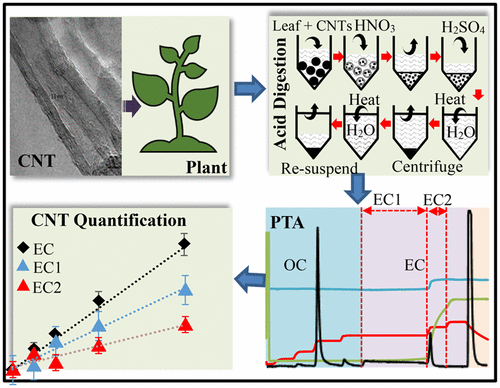当前位置:
X-MOL 学术
›
Environ. Sci. Technol. Lett.
›
论文详情
Our official English website, www.x-mol.net, welcomes your feedback! (Note: you will need to create a separate account there.)
Digestion Coupled with Programmed Thermal Analysis for Quantification of Multiwall Carbon Nanotubes in Plant Tissues
Environmental Science & Technology Letters ( IF 10.9 ) Pub Date : 2018-06-26 , DOI: 10.1021/acs.estlett.8b00287 Kamol K. Das 1 , Lucas Bancroft 2 , Xiaoliang Wang 2 , Judith C. Chow 2 , Baoshan Xing 3 , Yu Yang 1
Environmental Science & Technology Letters ( IF 10.9 ) Pub Date : 2018-06-26 , DOI: 10.1021/acs.estlett.8b00287 Kamol K. Das 1 , Lucas Bancroft 2 , Xiaoliang Wang 2 , Judith C. Chow 2 , Baoshan Xing 3 , Yu Yang 1
Affiliation

|
The rapidly growing application of carbon nanotubes (CNTs) for industry and consumer products will inevitably lead to their accumulation in the environment. Protection of food safety from contamination by CNTs and best-practice management of agricultural application of CNTs require quantification of CNTs in agricultural plants. Herein, a novel method of digestion coupled with programmed thermal analysis (PTA) was developed for quantitative analysis of multiwall CNTs (MWCNTs) in plant (lettuce) tissues. MWCNT-bound carbon was linearly correlated with elemental carbon (EC) detected by PTA, including EC1 (58.5%) (evolved at 580 °C) and EC2 (41.5%) (evolved at 740 °C), corresponding to less stable and stable carbon, respectively. The background plant materials could interfere with EC quantification of CNTs, as a substantial fraction of the plant biomass was charred during the thermal analysis. Sequential digestion with concentrated nitric acid (HNO3) and sulfuric acid (H2SO4) effectively minimized the interference caused by the lettuce tissues, reducing the background EC generated from leaf tissues to 10.73 ± 10.26 μg of C/g. Via the coupling of digestion with PTA, a detection limit of 64.9 μg of CNT-C/g of plant tissues was achieved. This method can be applied for unambiguous quantification of CNTs in plant tissues at low concentrations and provide critical information for evaluating the risk of exposure to CNTs through crops and optimizing applications of CNTs in agriculture.
中文翻译:

消化与程序热分析相结合定量植物组织中的多壁碳纳米管
碳纳米管(CNT)在工业和消费产品中的迅速增长的应用将不可避免地导致其在环境中的积累。为了保护食品安全免受碳纳米管的污染以及最佳实践管理碳纳米管在农业中的应用,需要对农业植物中碳纳米管进行量化。在本文中,开发了一种新颖的消化方法,结合程序热分析(PTA),可定量分析植物(生菜)组织中的多壁CNT(MWCNT)。MWCNT结合的碳与PTA检测到的元素碳(EC)呈线性相关,包括EC1(58.5%)(在580°C时进化)和EC2(41.5%)(在740°C时进化),相应地稳定性和稳定性较差碳。背景植物材料可能会干扰碳纳米管的EC定量,因为大部分植物生物质在热分析过程中被烧焦了。浓硝酸(HNO)顺序消化3)和硫酸(H 2 SO 4)有效地降低了莴苣组织造成的干扰,将叶片组织产生的背景EC降低至10.73±10.26μgC / g。通过消化与PTA的耦合,检测极限为64.9μgCNT-C / g植物组织。该方法可用于低浓度植物组织中CNT的明确定量,并为评估通过农作物接触CNT的风险以及优化CNT在农业中的应用提供关键信息。
更新日期:2018-06-27
中文翻译:

消化与程序热分析相结合定量植物组织中的多壁碳纳米管
碳纳米管(CNT)在工业和消费产品中的迅速增长的应用将不可避免地导致其在环境中的积累。为了保护食品安全免受碳纳米管的污染以及最佳实践管理碳纳米管在农业中的应用,需要对农业植物中碳纳米管进行量化。在本文中,开发了一种新颖的消化方法,结合程序热分析(PTA),可定量分析植物(生菜)组织中的多壁CNT(MWCNT)。MWCNT结合的碳与PTA检测到的元素碳(EC)呈线性相关,包括EC1(58.5%)(在580°C时进化)和EC2(41.5%)(在740°C时进化),相应地稳定性和稳定性较差碳。背景植物材料可能会干扰碳纳米管的EC定量,因为大部分植物生物质在热分析过程中被烧焦了。浓硝酸(HNO)顺序消化3)和硫酸(H 2 SO 4)有效地降低了莴苣组织造成的干扰,将叶片组织产生的背景EC降低至10.73±10.26μgC / g。通过消化与PTA的耦合,检测极限为64.9μgCNT-C / g植物组织。该方法可用于低浓度植物组织中CNT的明确定量,并为评估通过农作物接触CNT的风险以及优化CNT在农业中的应用提供关键信息。


























 京公网安备 11010802027423号
京公网安备 11010802027423号